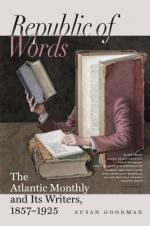And now of the various kinds of black and green teas.—But, Reader, I hear you cry, “Halt! halt! pray do not bore us with a dry catalogue of the ‘Padre Souchongs’ and ‘Twankays’; we know them already.”—Then speak for me, immortal Pindar Cockloft! crusty bachelor that thou art! who hast told that tea and scandal are inseparable, and hast so wittily described a gathering around the urn as
“A convention of tattling, a tea-party
hight,
Which, like meeting of witches, is brewed
up
at night,
Where each matron arrives fraught with
tales
of surprise,
With knowing suspicion and doubtful surmise;
Like the broomstick-whirled hags that
appear
in Macbeth,
Each bearing some relic of venom or death,
To stir up the toil and to double the
trouble,
That fire may burn, and that cauldron
may
bubble.
The wives of our cits of inferior degree
Will soak up repute in a little Bohea;
The potion is vulgar, and vulgar the slang
With which on their neighbors’ defects
they
harangue.
But the scandal improves,—a
refinement in
wrong!—
As our matrons are richer and rise to
Souchong.
With Hyson, a beverage that’s still
more refined,
Our ladies of fashion enliven their mind,
And by nods, innuendoes, and hints, and
what
not,
Reputations and tea send together to pot;
While madam in cambrics and laces arrayed,
With her plate and her liveries in splendid
parade,
Will drink in Imperial a friend at a sup,
Or in Gunpowder blow them by dozens all
up.”
There, now, Reader, you have the best classification extant of teas; and I will not detain you with any long descriptions of other kinds, seldom heard of by Americans, such as the “Sparrow’s Tongue,” the “Black Dragon,” the “Dragon’s Whiskers,” the “Dragon’s Pellet,” the “Flowery Fragrance,” and the “Careful Firing.”
Perhaps a notice of the great hongs will prove more interesting to you. They stretch for miles along the Canton River, and in the busy season are crammed with hundreds of thousands of chests, filled with the fragrant herb. The hongs front upon the river, in order that cargo-boats may approach them; but they have also another entrance at the end which opens from the suburbs. Imagine a building twelve hundred feet long by twenty to forty broad, and in some portions fifty feet high, built of brick, of one story, here and there open to the sky, with the floor as level as that of a ropewalk, and of such extent, that, to a person standing at one end, forms at the other end appear dwarfed, and men seem engaged in noiseless occupations: you have here the picture of a Chinese hong. In these warehouses the tea is assorted, repacked, and then put on board the chop-boats and sent down the river to the ships at their anchorage off Whampoa. Here are enormous scales for weighing




